Do you have a question about the Tripp Lite SmartPro SMART2200RMXL2U and is the answer not in the manual?
Guidance on proper placement of the UPS to ensure optimal performance and prevent damage, considering environmental factors.
Crucial safety advice for connecting the UPS to power sources and grounding, emphasizing electrical safety and warranty protection.
Precautions for connecting equipment to the UPS, especially regarding life support applications and preventing damage to UPS components.
Safety guidelines for handling UPS batteries, including shock risks, disposal, and replacement procedures, emphasizing authorized service.
Safety advice for connecting external battery packs, stressing compatibility and proper connection procedures to avoid damage.
Information on responsible recycling of Tripp Lite products and sealed lead-acid batteries, with contact details and website references.
Instructions for connecting the UPS to a properly grounded AC power outlet on a dedicated circuit for initial power-up.
Guidance on connecting electronic equipment to the UPS outlets, with advice on checking VA ratings to prevent overload.
Steps to power on the UPS system, including button press duration and expected audible feedback for successful startup.
Detailed instructions for installing the UPS into a 4-post rack, including shelf preparation, securing shelves, and attaching equipment.
Requirements for 2-post rack mounting, specifying the need for a Tripp Lite installation kit and the model number.
Instructions on how to adjust the LCD screen orientation when the UPS is mounted vertically in a tower configuration.
Connecting the UPS to a computer via USB or serial cable for management and monitoring using Tripp Lite PowerAlert Software.
Information on connecting the Emergency Power Off (EPO) port to a user-supplied switch for emergency shutdown of the UPS.
Guidance on connecting Tripp Lite external battery packs to extend UPS runtime, emphasizing compatibility and safety precautions.
Explains the UPS LCD display, including the 3-digit display and various icons and their meanings.
Details on operating the ON/OFF and MODE buttons for power control and menu navigation.
Explains the ENTER/MUTE button for toggling options, silencing alarms, and its combined use with other buttons.
Defines icons related to Battery Capacity, AC/Battery Input, Warnings, Events, and Alarm status.
Explains icons for Input/Output voltage, Load, Battery, Test, Runtime, Power units, and Sensitivity.
Shows UPS input/output voltage and estimated battery runtime in minutes.
Displays current load percentage, wattage, daily consumption, and remaining battery capacity.
Options to control audible alarms and adjust the LCD screen brightness.
Procedures for performing self-tests and configuring automatic display scrolling.
Features to view and reset counts for ON Battery and AVR events.
Adjusts UPS tolerance to AC input waveform distortions to manage battery switching frequency.
Controls for external battery configuration and resetting the UPS to factory default settings.
Description of rear panel ports including AC outlets, communication ports, EPO, accessory slot, and external battery connector.
Information on the output breaker for overload protection and the ground screw for chassis grounding.
Procedures for safely storing the UPS for extended periods, including battery care.
Steps for obtaining service, including troubleshooting, contacting support, and RMA process.
Detailed steps for replacing batteries in specific SMART3000RM models, covering panel removal and battery handling.
Instructions for installing new batteries and connecting them correctly, ensuring polarity and secure terminals.
Steps to reassemble the UPS by reinstalling the battery retention plate and front panel.
Procedure for replacing batteries in specific SMART models, covering panel removal, battery disconnection, and installation.
Statements regarding FCC Class A compliance and identification of regulatory compliance numbers.
Explanation of symbols used on the product label for AC and DC voltage indication.
Guidance on proper placement of the UPS to ensure optimal performance and prevent damage, considering environmental factors.
Crucial safety advice for connecting the UPS to power sources and grounding, emphasizing electrical safety and warranty protection.
Precautions for connecting equipment to the UPS, especially regarding life support applications and preventing damage to UPS components.
Safety guidelines for handling UPS batteries, including shock risks, disposal, and replacement procedures, emphasizing authorized service.
Safety advice for connecting external battery packs, stressing compatibility and proper connection procedures to avoid damage.
Information on responsible recycling of Tripp Lite products and sealed lead-acid batteries, with contact details and website references.
Instructions for connecting the UPS to a properly grounded AC power outlet on a dedicated circuit for initial power-up.
Guidance on connecting electronic equipment to the UPS outlets, with advice on checking VA ratings to prevent overload.
Steps to power on the UPS system, including button press duration and expected audible feedback for successful startup.
Detailed instructions for installing the UPS into a 4-post rack, including shelf preparation, securing shelves, and attaching equipment.
Requirements for 2-post rack mounting, specifying the need for a Tripp Lite installation kit and the model number.
Instructions on how to adjust the LCD screen orientation when the UPS is mounted vertically in a tower configuration.
Connecting the UPS to a computer via USB or serial cable for management and monitoring using Tripp Lite PowerAlert Software.
Information on connecting the Emergency Power Off (EPO) port to a user-supplied switch for emergency shutdown of the UPS.
Guidance on connecting Tripp Lite external battery packs to extend UPS runtime, emphasizing compatibility and safety precautions.
Explains the UPS LCD display, including the 3-digit display and various icons and their meanings.
Details on operating the ON/OFF and MODE buttons for power control and menu navigation.
Explains the ENTER/MUTE button for toggling options, silencing alarms, and its combined use with other buttons.
Defines icons related to Battery Capacity, AC/Battery Input, Warnings, Events, and Alarm status.
Explains icons for Input/Output voltage, Load, Battery, Test, Runtime, Power units, and Sensitivity.
Shows UPS input/output voltage and estimated battery runtime in minutes.
Displays current load percentage, wattage, daily consumption, and remaining battery capacity.
Options to control audible alarms and adjust the LCD screen brightness.
Procedures for performing self-tests and configuring automatic display scrolling.
Features to view and reset counts for ON Battery and AVR events.
Adjusts UPS tolerance to AC input waveform distortions to manage battery switching frequency.
Controls for external battery configuration and resetting the UPS to factory default settings.
Description of rear panel ports including AC outlets, communication ports, EPO, accessory slot, and external battery connector.
Information on the output breaker for overload protection and the ground screw for chassis grounding.
Procedures for safely storing the UPS for extended periods, including battery care.
Steps for obtaining service, including troubleshooting, contacting support, and RMA process.
Detailed steps for replacing batteries in specific SMART3000RM models, covering panel removal and battery handling.
Instructions for installing new batteries and connecting them correctly, ensuring polarity and secure terminals.
Steps to reassemble the UPS by reinstalling the battery retention plate and front panel.
Procedure for replacing batteries in specific SMART models, covering panel removal, battery disconnection, and installation.
Statements regarding FCC Class A compliance and identification of regulatory compliance numbers.
Explanation of symbols used on the product label for AC and DC voltage indication.
| Brand | Tripp Lite |
|---|---|
| Model | SmartPro SMART2200RMXL2U |
| Category | UPS |
| Language | English |
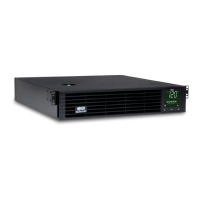

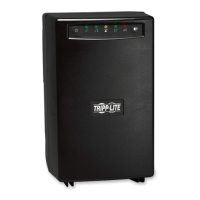
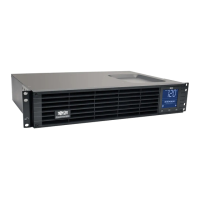
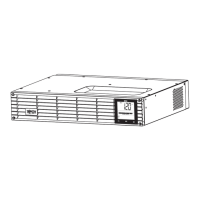




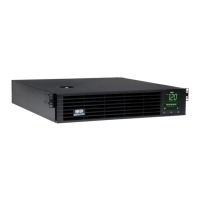
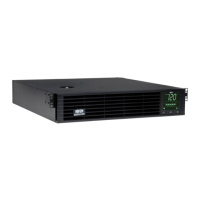

